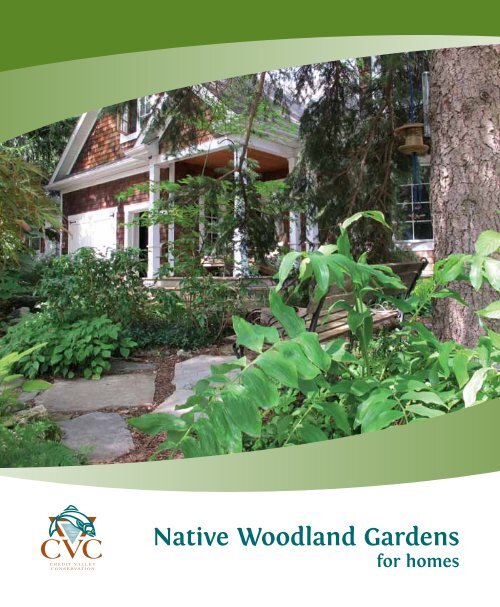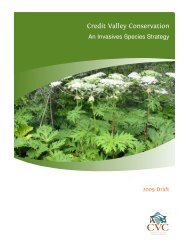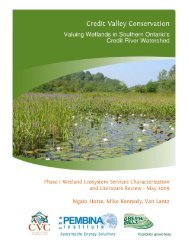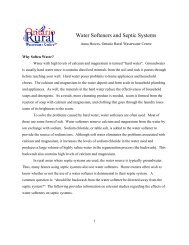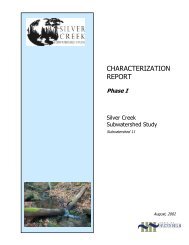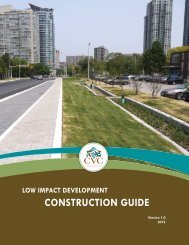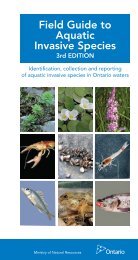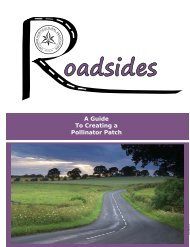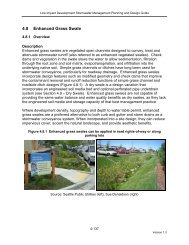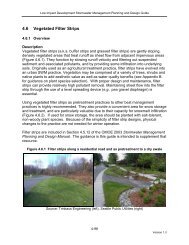Native Woodland Gardens for Homes - Credit Valley Conservation
Native Woodland Gardens for Homes - Credit Valley Conservation
Native Woodland Gardens for Homes - Credit Valley Conservation
You also want an ePaper? Increase the reach of your titles
YUMPU automatically turns print PDFs into web optimized ePapers that Google loves.
<strong>Native</strong> <strong>Woodland</strong> <strong>Gardens</strong><br />
<strong>for</strong> homes
3<br />
4<br />
6<br />
8<br />
9<br />
16<br />
18<br />
19<br />
20<br />
22<br />
23<br />
contents<br />
<strong>Native</strong> <strong>Woodland</strong> <strong>Gardens</strong><br />
Benefits<br />
A Forest is More Than Trees: Forest<br />
Communities<br />
Steps to Establishing a <strong>Woodland</strong> Garden<br />
- Know Your Yard<br />
- Select Your Community and Your Plants<br />
- Other Design Considerations<br />
- Prepare Your Garden Area<br />
- Installation<br />
- Maintenance<br />
References and Added Resources<br />
2
<strong>Native</strong> <strong>Woodland</strong><br />
<strong>Gardens</strong><br />
One wonderful way to help sustain a healthy<br />
environment while adding a beautiful feature to your<br />
home is by growing a small <strong>for</strong>est or woodland<br />
garden. You can start with any situation — existing<br />
trees, flower beds, even lawn can be converted.<br />
Most of Southern Ontario was once covered in<br />
magnificent native <strong>for</strong>ests and woodlands with<br />
pockets of wetlands, prairies and meadows. The<br />
<strong>Credit</strong> River and nearby urban watersheds were<br />
home to several types of <strong>for</strong>ests including, among<br />
others, sugar maple, oak-hickory, ash and hemlock.<br />
Some of the sandier areas contained a rare<br />
community in the province, oak savannah.<br />
First Nations carved out small settlements and<br />
walking trails. When Europeans arrived in the<br />
late 1700s, they de<strong>for</strong>ested much of the area <strong>for</strong><br />
farming, buildings, shipbuilding, firewood and other<br />
wood products. As human settlement increased,<br />
the <strong>for</strong>ests continued to decline. With recent<br />
re<strong>for</strong>estation, restoration and ecological landscaping<br />
ef<strong>for</strong>ts, we are slowly starting to see an increase in<br />
<strong>for</strong>est cover.<br />
You can help sustain and restore our <strong>for</strong>ests and<br />
our unique natural heritage in your home landscape.<br />
Every piece of land, large or small, can contribute!<br />
photo: Green Insight<br />
3
Benefits<br />
<strong>Woodland</strong> gardens can help enhance the urban <strong>for</strong>est<br />
and <strong>for</strong>est cover across the watershed. Urban <strong>for</strong>ests are<br />
essential <strong>for</strong> helping to reduce climate change and urban<br />
heat. They can also provide shelter from wind and snow<br />
in winter.<br />
<strong>Woodland</strong> gardens help sustain and enhance the remaining<br />
pockets of historic <strong>for</strong>est and the beautiful native plants that<br />
live there, both of which are diminishing in our watershed<br />
and across the province.<br />
<strong>Woodland</strong> gardens create habitat <strong>for</strong> birds, pollinating<br />
insects such as butterflies, and other wildlife. A<br />
neighbourhood with many woodland gardens can help<br />
create a connection between nearby natural areas, making<br />
it easier <strong>for</strong> animals and plants to move between their<br />
natural habitats.<br />
Other benefits to you and the wider community include:<br />
• Improved air, soil and water quality<br />
• Improved water quantity, by helping water soak into the<br />
ground and reducing the need <strong>for</strong> watering<br />
• Reduced heating and air conditioning costs, and related<br />
use of energy and other natural resources<br />
• Reduced maintenance costs, time, equipment and noise<br />
pollution once the garden is established<br />
• Less costly than replacing annuals every year<br />
A woodland garden provides an attractive natural alternative<br />
to lawn and standard garden beds, and can even be grown<br />
on rooftops or balconies. A woodland garden can be a<br />
welcome green oasis <strong>for</strong> you, your family and your friends.<br />
4
Canopy layer<br />
photo: Bob Morris<br />
Subcanopy layer Shrub layer Groundcover layer<br />
photo: Bob Morris<br />
A Forest is More Than Trees:<br />
Forest Communities<br />
If you explore the natural woodlands and <strong>for</strong>ests growing nearby, you will note different types<br />
of plants: trees, shrubs and ground vegetation. Together, they make up the four layers in a<br />
woodland:<br />
• Canopy – tallest trees<br />
• Sub-canopy – smaller trees<br />
• Understory – shrubs<br />
• Ground layer – mosses, grasses, ferns and wildflowers<br />
A woodland garden includes native plants from three or all four of these layers. There are several<br />
types of native <strong>for</strong>ests in the <strong>Credit</strong> River Watershed, each of which have different plants in the<br />
layers. To learn more about the specific <strong>for</strong>est communities and plants of the <strong>Credit</strong> River and<br />
nearby urban watersheds, see <strong>Credit</strong> <strong>Valley</strong> <strong>Conservation</strong>’s (CVC) <strong>Native</strong> <strong>Woodland</strong> & Forest<br />
Plants <strong>for</strong> Landscaping.<br />
Forests also consist of the animals that live there or travel through on migration routes, and the<br />
air, soil and water that help sustain vegetation and wildlife.<br />
6
photo: Jon Clayton<br />
7
Steps to Establishing a <strong>Woodland</strong> Garden<br />
For a hobby gardener or naturalist, establishing and maintaining a native woodland garden will<br />
likely be a pleasurable experience. Those who prefer minimal gardening can start small and<br />
build up the garden over time. Some may prefer to hire an ecological landscaping or gardening<br />
firm to help out.<br />
The basic steps are the same regardless of how or what you choose to install:<br />
1. Understand your site (Know Your Yard)<br />
2. Select your preferred community and specific plants<br />
3. Consider other design factors<br />
4. Prepare your garden area<br />
5. Install your garden<br />
6. Maintain your garden<br />
8
1. Know Your Yard<br />
There are a few types of woodlands and associated plants in our watershed, based on the<br />
ecosystems in which they evolved. For example, <strong>for</strong>ests may have evolved along stream edges,<br />
on sandy or rocky beaches along Lake Ontario, on the clay soils of the Peel plain or on sandy<br />
pockets in the Oak Ridges Moraine. It is best to grow a woodland and associated plants that<br />
are suited to your site conditions.<br />
A few basic pieces of in<strong>for</strong>mation are essential <strong>for</strong> successful native woodland gardens:<br />
Soil Type and Moisture<br />
Dig down to check your soil in several<br />
locations in your yard where you may<br />
plant a woodland.<br />
The main soil-related factors to consider<br />
include:<br />
• Soil types<br />
• Moisture levels<br />
• Ph (acidity)<br />
What kind of soil do you have: sand, clay,<br />
loam, or a mix?<br />
Some simple field tests can help you determine your soil type and moisture levels. Refer to<br />
CMHC’s Know Your Soils fact sheet (see references). Ph can be assessed by a simple garden<br />
centre meter. Low Ph is a good place <strong>for</strong> coniferous or mixed <strong>for</strong>est.<br />
Note that soils in many urban and previously farmed or mined environments, such as pits and<br />
quarries, have been altered. You can improve your soil to aid with planting and/or start with<br />
hardy species that can tolerate current soil conditions. Over time the plantings will help improve<br />
your soil so you can add more sensitive species at a later date.<br />
9
Shade<br />
How much shade does your intended<br />
planting location receive throughout the<br />
day?<br />
<strong>Woodland</strong> plants thrive in shade or part<br />
shade. How many hours of sunlight does<br />
your yard get?<br />
0-4 hours = full shade<br />
4-6 hours = part shade<br />
6+ hours = full sun<br />
Shade from existing trees can create ideal conditions <strong>for</strong> woodland plantings. If some of your<br />
yard gets full sun you can grow woodland edge species, grow a full woodland garden over time<br />
as it starts to get shadier, or consider a native prairie or meadow garden in that location. See<br />
CVC’s Ecological Landscaping Resources <strong>for</strong> more in<strong>for</strong>mation.<br />
Wind<br />
Are there windy areas in your yard that<br />
could be protected? What is the dominant<br />
wind direction?<br />
<strong>Woodland</strong> gardens can help protect your<br />
home from wind and help you reduce energy<br />
use. In excessively windy areas, plant hardy<br />
species that do not break easily such as<br />
hardwoods and dense evergreens.<br />
10
Existing Plants<br />
Take note of any existing native and nonnative<br />
plants on your site.<br />
An existing tree or shrub bed may be an<br />
excellent place to start. <strong>Native</strong> plants that are<br />
thriving on your site are also a good clue as to<br />
what might work best.<br />
Some non-native species are relatively<br />
harmless, and you can choose to keep them or<br />
remove them. It is best to remove any invasive<br />
plants and cultivars of native plants. For a list of<br />
invasives, see CVC’s Most Unwanted Invasive<br />
Garden Plants. Cultivars are native plants that genetically are altered <strong>for</strong> specific traits such as<br />
larger flowers. Cultivars can cross breed with native plants and weaken their adaptations to local<br />
conditions so are generally not recommended. You can remove all unwanted plants at once, or<br />
gradually as your native woodland garden evolves.<br />
Check also <strong>for</strong> existing native plants or plant communities on adjacent sites, such as a<br />
neighbour’s woodland garden or a public <strong>for</strong>est. If the plants are thriving and site conditions are<br />
similar, you may want to complement the feature with a similar community type. Many small<br />
spaces together can help create larger habitats. Refer also to the discussion on selecting your<br />
community in Step 2.<br />
Do not use toxic herbicides to kill unwanted vegetation. There is a province-wide ban on the use<br />
of cosmetic pesticides in Ontario. Although they can be used by qualified applicators to remove<br />
some particularly harmful pests, hand pulling weeds and other more natural methods of dealing<br />
with pests are preferred. Pesticides can kill healthy soil bacteria and nutrients, pollute the air<br />
and water, harm desirable insects and other animals, such as pets, frogs and birds. Some are<br />
harmful to human health. See the resources section on page 23 <strong>for</strong> more in<strong>for</strong>mation.<br />
11
Slopes and Drainage<br />
Do you have any slopes or low-lying areas<br />
in your yard?<br />
Check <strong>for</strong> slopes and depressions. Plants can<br />
help reduce erosion and make maintenance<br />
of those hard-to-mow slopes easier. It is<br />
best to select plants that are suited to slopes<br />
as noted on CVC’s <strong>Native</strong> <strong>Woodland</strong> &<br />
Forest Plants <strong>for</strong> Landscaping. Ensure that<br />
the plants you select are also suited to the<br />
direction of the sun and wind.<br />
Also, watch the way water or snow melt drains in your yard. Areas that drain more slowly or<br />
are seasonally wet may be a great location <strong>for</strong> a wetter community type such as red maple or<br />
mixed <strong>for</strong>est <strong>for</strong> wet-moist sites.<br />
Infrastructure<br />
Note under- and above-ground<br />
infrastructure to ensure you do not do any<br />
damage or create a safety problem.<br />
Above ground, make note of overhead wires,<br />
utility poles, fences, surrounding buildings<br />
and foundations, and other built elements.<br />
Plant the right sizes and/or maintain proper<br />
distances from infrastructure so that your<br />
trees and shrubs have plenty of room to grow.<br />
Underground, there may be gas pipelines,<br />
cables, water and sewer connections. To<br />
reduce the possibility of injury to yourself or damage to underground services, contact your<br />
municipality be<strong>for</strong>e you dig.<br />
12
Available Space<br />
Choose areas where you may want to<br />
grow or expand a woodland planting.<br />
Assess how much space you have to work<br />
with and what existing elements, such as<br />
a garden shed or deck, you have to work<br />
around.<br />
A few things to consider include:<br />
• Elements you will not likely change such as<br />
your driveway and main pathways.<br />
• Are there unused areas in your yard where<br />
you could plant?<br />
• What do you do in your yard? Do you want your woodland near or far from these activities?<br />
• Would you like to look out at your woodland from your deck or have it welcome people at<br />
the front of your house or both?<br />
• Consider all uses of your site. For example, do people take a shortcut across your yard?<br />
Plant taller species to block this, or create a path to allow it.<br />
• Remember that your trees and shrubs will grow much larger. Plan <strong>for</strong> what they will look like<br />
in 20 years.<br />
• Place large trees a minimum of 3 metres away from your house.<br />
digging in your yard?<br />
Be careful not to dig where you could hit underground pipes, cables or wires. A week or more<br />
be<strong>for</strong>e you plan to dig, call your municipality at 311 or a general in<strong>for</strong>mation line. They will<br />
identify the various utilities you need to call. In some cases, a representative will come to your<br />
house and mark the locations of the utilities. In other cases, service providers will give you<br />
instructions about the best approach <strong>for</strong> ensuring safety.<br />
13
Special Challenges<br />
For example: compaction, salt, pollutants.<br />
Plants living in cities, or beside roads or some<br />
industries, may face added stresses.<br />
Compaction. Avoid excessive foot or vehicle<br />
traffic through the garden. Loosen soil with a<br />
pitch<strong>for</strong>k or other tool occasionally if needed.<br />
Keep your soil relatively loose and aerated to<br />
help sustain plant health.<br />
De-icing Salt. Salt applied to roads and<br />
sidewalks in winter can have negative effects<br />
on your garden. Avoid planting salt-sensitive<br />
plants in areas where road salt is sprayed. Look <strong>for</strong> a more environmentally-friendly alternative,<br />
such as sand, and use it sparingly on your own driveway and walkways. Permeable paving also<br />
helps reduce the need <strong>for</strong> de-icing.<br />
Other Air and Water Pollutants. Pollution from car emissions or some industries can<br />
contaminate the plants’ air and water. Avoid planting sensitive plants right next to areas with<br />
excessive vehicle exhaust or beside industries with notable pollutants. Work with hardy or<br />
emissions-tolerant plants in these areas. There is very little published in<strong>for</strong>mation on plants and<br />
emissions, but you can ask your supplier <strong>for</strong> recommendations.<br />
14
Sugar maple (Acer saccarinum)<br />
2. Select Your Community and Your Plants<br />
You can discover what grows naturally in your local area by exploring local remnant natural<br />
areas. Other local resources include:<br />
• CVC’s Ecological Landscaping Resources web page<br />
• CVC’s Your Green Yard workshops (see CVC’s website)<br />
• City of Mississauga’s Natural Areas Survey<br />
• If you are outside Mississauga, check with your local municipal parks department or<br />
naturalist club <strong>for</strong> added resources <strong>for</strong> your area.<br />
A cautionary note that in many areas of our watershed, you will find a mix of native and nonnative<br />
species in remnant woodlands. Non-natives generally migrated from farms or gardens, or<br />
were accidentally introduced. A true native garden will only include native species, but you can<br />
choose whether or not to include any “friendly” non-native plants. As noted above, do not plant<br />
invasives or cultivars of native plants.<br />
16
Christmas fern (Polystichum acrostichoides)<br />
Wild columbine (Aquilegia canadensis)<br />
Once you have selected the preferred community suited to your area and site, refer to CVC’s<br />
<strong>Native</strong> <strong>Woodland</strong> & Forest Plants <strong>for</strong> Landscaping <strong>for</strong> some species you can grow. Select a<br />
mix of trees, shrubs and ground layer plants.<br />
You can also choose plants that will provide interest and colour through all seasons such as<br />
sugar maple <strong>for</strong> vibrant fall colour, ferns <strong>for</strong> attractive summer foliage, or wild columbine <strong>for</strong><br />
showy spring blooms.<br />
Although all native plant gardens will provide habitat <strong>for</strong> wildlife, you can plant a few species that<br />
produce especially attractive food or shelter <strong>for</strong> birds, butterflies or other special wildlife. Refer<br />
to CVC’s Ecological Landscaping Resources web page <strong>for</strong> more in<strong>for</strong>mation.<br />
Nurseries that specialize in native plants can also help you select suitable plants. Refer to CVC’s<br />
<strong>Native</strong> Plant Nurseries and Seed Sources.<br />
17
3. Other Design Considerations<br />
It helps to sketch your ideas on a piece of paper. You can draw a bird’s-eye view of your yard<br />
or work with an aerial photo, placing your woodland garden and any other design features on<br />
the page. Make a list of your site observations, and note your preferred community and species.<br />
Also, measure the space <strong>for</strong> your new garden so you know how many plants to grow.<br />
Other considerations when designing your garden include:<br />
• If you do not have a shaded yard you can create shade quickly with a trellis, fence or arbour,<br />
or wait until your new trees grow.<br />
• For safety reasons, avoid softwood trees right beside your home or garage.<br />
• For a more natural look, avoid planting in straight lines.<br />
• For added attractiveness, plant taller growing species toward the back or centre of your<br />
garden and shorter plants toward the front.<br />
• Create privacy or hide fences and other less attractive parts of your site with dense shrubs or<br />
small trees.<br />
• You can plant ground cover <strong>for</strong> fuller coverage and a more natural look, or intersperse plants<br />
with mulch <strong>for</strong> a “neater” appearance. In a garden setting, the choice is a matter of personal<br />
preference.<br />
18<br />
photo: Alice Kong photo: James Dale
make a good green impression!<br />
You can help dispel the idea that native plant gardens are “messy” and promote them as<br />
naturally beautiful alternatives to more manicured spaces by following a few simple guidelines:<br />
• Control the spread of invasive species and noxious weeds. Remove by hand, getting all<br />
the root and root pieces. Note that many cities and towns have noxious weed by-laws with<br />
lists of noxious weeds that must be removed.<br />
• Maintain a neat garden edge. Use decorative stone mulch along edges, or plant a border<br />
of low-growing ground covers or small shrubs to frame the garden.<br />
• Make the garden look designed and inviting. Create added visual appeal with a rock, a<br />
bench or a garden sculpture. If you have space, plan a path and possibly a seating area in<br />
your garden.<br />
• Do not block street views. Ensure that your plants do not create a safety hazard <strong>for</strong><br />
vehicles or pedestrians. Prune or thin as needed.<br />
• Talk to your neighbours. Explain to your neighbours what you are doing and the<br />
environmental and personal benefits of your new garden. They may want to try it too.<br />
To help keep your garden attractive and safe over time, see more tips in the Maintenance<br />
section on page 22.<br />
4. Prepare Your Garden Area<br />
There are two recommended ways to remove lawn to prepare a new garden bed:<br />
• Cutting. Remove lawn using a shovel, cutting horizontally. Remove all visible root pieces.<br />
You may need to add topsoil - add the best soil type <strong>for</strong> your chosen plant community. Plant<br />
into the new soil.<br />
• Smothering. Cover the lawn using several layers of wet newspaper or biodegradable plastic<br />
landscaping fabric and cover with 10-15 cm of topsoil. Plant into this new soil. Roots of the<br />
new plants will break through the fabric or newspaper. For more deeply rooted plants, cut<br />
the fabric or paper only where you want to plant.<br />
19
Garden bed preparation:<br />
smothering<br />
photo: Melanie Kramer<br />
Adding new topsoil<br />
photo: Melanie Kramer<br />
Coconut coir (husks) added<br />
to heavy clay <strong>for</strong> aeration<br />
photo: Melanie Kramer<br />
Whichever method you choose, be prepared to pull extra weeds <strong>for</strong> a year or two until the new<br />
vegetation is established and lawn seeds and roots are gone.<br />
The addition of organic matter may or may not be desirable, depending on your soil and your<br />
selected plants. Some plants thrive in sandy or clay soils; others require improved nutrients,<br />
moisture and/or drainage provided by organic matter. Note that the plants themselves will<br />
also help improve soil conditions over time. If appropriate <strong>for</strong> your site, work in compost or<br />
decomposing leaves to a depth of 10-15 cm.<br />
If you are gardening beneath an existing tree avoid damaging the tree roots and do not bury the<br />
root crown if you need to add soil.<br />
5. Installation<br />
Purchase from a native plant nursery that provides locally sourced seeds and plants. The<br />
closer the seed source to your area of the watershed, the better the plant will grow in your<br />
soil and weather conditions, and the more you will be contributing to restoring local native<br />
biodiversity. Watch <strong>for</strong> plants available in some nurseries and garden centres that are labelled<br />
“native” but come from far away, are native to other regions of Canada but not to our area, or<br />
are cultivars of natives.<br />
You can combine seeding of ground layer herbaceous plants with planting woody plants, or<br />
only work with plants. Seeding in a ground layer will be less expensive and can help reduce<br />
weeds, but it will take a little longer to establish. Most home gardeners prefer not to plant<br />
woody seeds, but you can try. Until they are established, you may need to protect woody seeds<br />
and seedlings from squirrels and other wildlife with small wire cages.<br />
20
May to mid-June is the best time to plant because temperatures are right and rainfall is<br />
usually abundant. Mid-September to mid-October is also a good time to plant but some<br />
trees may not do as well during this period. Refer to CVC’s <strong>Native</strong> <strong>Woodland</strong> & Forest Plants<br />
<strong>for</strong> Landscaping <strong>for</strong> species that are more sensitive to fall planting. Planting can be done in<br />
summer, but it is not the preferred time as they will likely require too much water. Bare root<br />
plants are best planted in early spring or late fall when they are dormant.<br />
Seeding is best done in late October to late November. Seed will lie dormant until spring and will<br />
start to germinate with the spring thaw. Seeding can be done in spring provided seeds are prestratified<br />
(ask your supplier). Seeding in summer is not recommended as seeds and seedlings<br />
will be more vulnerable to heat stress.<br />
With increasingly erratic weather due<br />
to climate change, you may lose some<br />
plants or seedlings due to untimely<br />
heat waves, frost or floods. You can<br />
replace with new plants if necessary.<br />
You can also expect some normal<br />
dieback of trees and shrubs as they<br />
adapt to being moved. You can prune<br />
dead branches and the plants will<br />
generally revive over a season.<br />
Space trees 1-3 metres apart depending on the anticipated size of the plant. Shrubs can<br />
be spaced 1/2 to 1 metre, and ground layer spacing will generally be at 15-30 cm. Be<strong>for</strong>e<br />
planting set your plants out where you want them to go. Then adjust according to their spacing<br />
requirements and your preferences.<br />
For instructions about how to plant trees and shrubs, refer to CVC’s How to Plant a Potted<br />
Tree or Shrub.<br />
If seeding, follow the nursery guidelines <strong>for</strong> volume of seed and planting instructions. Most<br />
herbaceous seeds are best mixed with light soil and gently raked into the ground surface.<br />
Gently press the seed into contact with the soil being careful not to crush the seed or compact<br />
the soil. If seeding in spring, water with a light mist until the soil is moist. Repeat the light<br />
21
watering daily, unless there is rain, until the seeds germinate. If seeding in fall, do not water as it<br />
is best if the seeds lie dormant until spring thaw.<br />
You may wish to apply mulch over your new garden bed to help retain moisture, reduce weed<br />
growth and insulate new plants from seasonal extremes. Do not apply mulch over seeds as it<br />
will bury the seeds. Apply only a thin straw mulch blanket if needed to retain seeds on a slope.<br />
As the garden matures, falling leaves will provide a natural mulch.<br />
6. Maintenance<br />
Keep new plantings moist <strong>for</strong> the first few weeks, and after that water regularly during dry<br />
periods. To conserve drinking water, water from a rain barrel. Provide enough water to keep<br />
deep roots moist. Trees and shrubs need more water than herbaceous plants.<br />
Until your garden is established, you will need to remove weeds regularly. Pull the weeds by<br />
hand, ensuring the whole root is removed but keeping soil disturbance to a minimum. This is<br />
easiest done after a rainfall when the soil is moist. Top up mulch as necessary to keep moisture<br />
in and weeds out.<br />
As your garden becomes established, you will need to weed<br />
less often. If your neighbours have invasive plants they do<br />
not want to remove, you may need to remove them from your<br />
yard regularly. Watering will only be needed during drought if<br />
plants are showing signs of drying or heat stress.<br />
You can prune sparingly and watch <strong>for</strong> particularly damaging<br />
insects or diseases. As noted, it is best to use non-toxic<br />
methods to treat diseases or insects whenever possible.<br />
Your plantings will start to spread and new native plants may<br />
appear - you can control those or let them be. For more<br />
details on long term maintenance requirements see CVC’s<br />
<strong>Woodland</strong> Planting After-care fact sheet.<br />
Sit back and enjoy your wonderful new habitat. Watch as<br />
others join you and our cities gradually grow greener!<br />
22
References and Added Resources<br />
<strong>Credit</strong> <strong>Valley</strong> <strong>Conservation</strong> website www.creditvalleyca.ca<br />
• Ecological Landscaping Resources www.creditvalleyca.ca/landscaping<br />
• Your Green Yard Program www.creditvalleyca.ca/ygy<br />
• <strong>Native</strong> <strong>Woodland</strong> & Forest Plants <strong>for</strong> Landscaping (pdf) www.creditvalleyca.ca/woodlandplants<br />
• <strong>Native</strong> Plant Nurseries and Seed Sources (pdf) www.creditvalleyca.ca/nurseries<br />
• How to Plant a Potted Tree or Shrub (pdf) www.creditvalleyca.ca/howtoplant<br />
• <strong>Woodland</strong> Planting After-care (pdf) www.creditvalleyca.ca/aftercare-woodland<br />
• The Most Unwanted Invasive Garden Plants (pdf)<br />
www.creditvalleyca.ca/unwanted-invasive-garden-plants<br />
• Resource Library www.creditvalleyca.ca/resource-library<br />
City of Brampton. Urban Forestry webpages. www.brampton.ca/en/residents/trees-plants-flowers<br />
1996-2010. City of Mississauga. Natural Areas Survey.<br />
www5.mississauga.ca/research_catalogue/F_14_NAS_2009_Update.pdf<br />
City of Mississauga. Urban Forestry webpages. www.mississauga.ca/portal/residents/urban<strong>for</strong>estry<br />
2009. City of Toronto. Go Natural in the Garden fact sheet series.<br />
www.toronto.ca/health/pesticides/go_natural_factsheets.htm<br />
2000. Daigle, Jean-Marc and Donna Havinga. Restoring Nature’s Place: A Guide to<br />
Naturalizing Ontario Parks and Greenspace. Schomberg: Ecological Outlook and<br />
Ontario Parks Association. Available from info@ecologicaloutlook.ca (<strong>for</strong> advanced<br />
gardeners/landscape managers).<br />
2004. Havinga, Donna <strong>for</strong> Canada Mortgage and Housing (CMHC). Know Your Soils<br />
fact sheet. Ottawa: CMHC. www.cmhc-schl.gc.ca/en/co/maho/la/la_001.cfm<br />
1999. Johnson, Lorraine. 100 Easy-to-grow <strong>Native</strong> Plants <strong>for</strong> Canadian <strong>Gardens</strong>.<br />
Toronto: Whitecap.<br />
Region of Peel. Water Smart Peel gardening in<strong>for</strong>mation and rain barrels.<br />
www.peelregion.ca/watersmartpeel/outdoor<br />
For more in<strong>for</strong>mation, contact CVC Urban Outreach at 905-670-1615, email<br />
greencities@creditvalleyca.ca.<br />
© 2012, <strong>Credit</strong> <strong>Valley</strong> <strong>Conservation</strong>. For permission to reprint or post on a website<br />
contact Supervisor, Urban Outreach at CVC.<br />
23
1255 Old Derry Road<br />
Mississauga, Ontario L5N 6R4<br />
Phone: 905-670-1615<br />
Toll Free: 1-800-668-5557<br />
Fax: 905-670-2210<br />
Website: www.creditvalleyca.ca<br />
E-mail: cvc@creditvalleyca.ca


